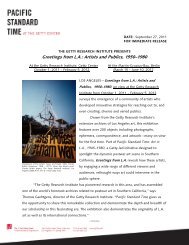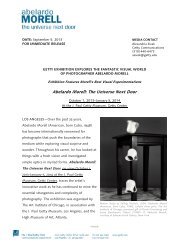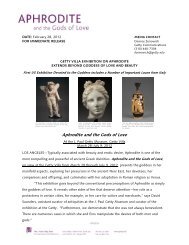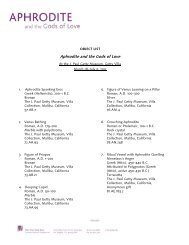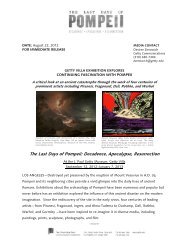Exhibitions at The GETTY - News from the Getty
Exhibitions at The GETTY - News from the Getty
Exhibitions at The GETTY - News from the Getty
You also want an ePaper? Increase the reach of your titles
YUMPU automatically turns print PDFs into web optimized ePapers that Google loves.
Renaissance Drawings <strong>from</strong> Germany<br />
and Switzerland, 1470–1600<br />
March 27–June 17, 2012<br />
Dancing Peasant Couple, 1525. Urs Graf (Swiss, about<br />
1485‐1527). Pen and gray and black ink; pricked for<br />
transfer (recto); Rubbed with black chalk (verso). <strong>The</strong><br />
J. Paul <strong>Getty</strong> Museum, Los Angeles.<br />
<strong>The</strong> period of 1480–1660 represents one of <strong>the</strong> high points in<br />
German art, spanning <strong>the</strong> careers of artists such as Martin<br />
Schongauer, Albrecht Dürer, Lucas Cranach <strong>the</strong> Elder, and Hans<br />
Holbein <strong>the</strong> Younger. Because different styles of drawing developed<br />
in <strong>the</strong> various regions of present-day Germany and Switzerland, this<br />
exhibition of works <strong>from</strong> <strong>the</strong> <strong>Getty</strong> Museum's permanent collection<br />
is organized by region—<strong>the</strong> Middle and Upper Rhine, Switzerland,<br />
Nuremberg, and Saxony. <strong>The</strong> exhibition explores <strong>the</strong> drawings'<br />
wide range of functions and captiv<strong>at</strong>ing subject m<strong>at</strong>ter, including<br />
mercenary soldiers and scenes of courtly love. It also presents<br />
important new scholarship in <strong>the</strong> field th<strong>at</strong> has been accomplished<br />
during <strong>the</strong> past decades.<br />
J. Paul <strong>Getty</strong> Museum<br />
<strong>at</strong> <strong>the</strong> <strong>Getty</strong> Center<br />
Media Contact<br />
Alexandria Sivak<br />
310.440.6473<br />
asivak@getty.edu<br />
Aphrodite and <strong>the</strong> Gods of Love<br />
March 28–July 9, 2012<br />
From her genesis among earlier deities in <strong>the</strong> ancient Near East to<br />
her adoption in Roman culture as Venus, this exhibition explores<br />
<strong>the</strong> realms of Aphrodite, Greek goddess of love. It moves beyond<br />
<strong>the</strong> familiar aspects of desire, seduction, feminine beauty, and<br />
sexuality to demonstr<strong>at</strong>e <strong>the</strong> various facets of this complex divinity:<br />
civic protectress, helper to sailors, and manipul<strong>at</strong>or of mortals.<br />
Organized by <strong>the</strong> Museum of Fine Arts, Boston, in associ<strong>at</strong>ion with<br />
<strong>the</strong> J. Paul <strong>Getty</strong> Museum, <strong>the</strong> exhibition includes objects ranging<br />
<strong>from</strong> large-scale sculpture to delic<strong>at</strong>e jewelry drawn <strong>from</strong> both<br />
museums' collections as well as major loans <strong>from</strong> Italian<br />
institutions.<br />
Head of Aphrodite (<strong>The</strong> Bartlett Head), Greek, about<br />
330-300 B.C. Unknown artist. Parian marble.<br />
Museum of Fine Arts, Boston. Francis Bartlett<br />
Don<strong>at</strong>ion of 1900.<br />
J. Paul <strong>Getty</strong> Museum<br />
<strong>at</strong> <strong>the</strong> <strong>Getty</strong> Villa<br />
Media Contact<br />
Desiree Zenowich<br />
310.440.7304<br />
dzenowich@getty.edu<br />
4/17





